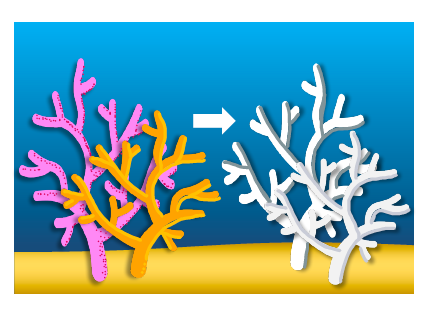22 Apr Young Reporter’s for the Environment programme

THE ENVIRONMENTAL CONNECTION
Every corner of Planet Earth is enriched with natural wonders from jaw dropping glaciers in Iceland to the magnificent Cliffs of Moher in Ireland all the way to the vast Sahara Desert in Africa. A rich variety of wildlife flourish in the rainforests and the oceans. Nature beautifies our world but also brings great benefits to society. But sadly, we are facing threats that are damaging our environment. Climate change, littering, pollution is all negatively impacting our planet. Many environmental events that are happening in the world are linked in some way and let’s see how this happens by looking at one of nature’s stunning wonders.
Bursting with vivid and vibrant colors, corals reefs brighten up the ocean waters beautifully. [1] They are structures built up by colonial marine invertebrates called coral. Corals are located worldwide. [2] They occupy more than 100 countries and make up an estimated figure of 284,300 square kilometers. Most reefs are found between the Tropics of Cancer and Capricorn in the Pacific Ocean, the Indian Ocean, the Caribbean Sea, the Red Sea and the Persian Gulf.
For a very long time period, we have heard terms like pollution and global warming that are becoming a danger to our home. As with all wonders of nature, these problems are impacting corals as well. One of the most severe threats to the coral life is coral bleaching. A factor that causes coral bleaching is an issue that we are very familiar with. This i ssue is Climate Change.
ssue is Climate Change.
We know corals possess many vibrant colors which that makes them stand out.
[3] Well, corals have their colors because of a microscopic alga called zooxanthellae. Corals are home to this kind of algae, and they maintain a mutually beneficial relationship, meaning they support each other for survival. But when an unsuitable ocean environment occurs such as warming of ocean waters, corals stress out and evict this alga that inhabits them. As a result, the natural color of the coral is drained out i.e., coral bleaching. [4] During the years 2014 to 2017, global bleaching occurred and affected 75% of coral reefs.
Pollution can also affect the health of corals. [5] Corals can have an impact from run–off waste sediments such as excess fertilizers and pesticides. Wastes in landfills and coastal dumps can have a direct impact to the coral environment or by releasing unhealthy toxins into inshore water which can potentially cause harm to corals.
Deforestation and clearing of farmlands can result in sediment erosion which can seep into rivers then to coastal waters.
Changes in precipitation due to climate change can also affect sediment sun-off.
Corals are such great wonders. They come very beneficial to humanity and to other elements of nature. [6] They help human beings in the form of jobs and opportunities for recreation. Over half a billion people look up to corals for income, food and protection. Apart from that, corals provide a shelter for many sea organisms to find food and reproduce as 25% of the ocean’s fish depend on them. From this, it is understood that coral reefs are very advantageous and comes as a great help to many people therefore a negative impact to corals will have the same result on the people that depend on them.
Climate change is a global crisis that has an enormous impact on coral reefs and our planet as a whole. So far, pollution, climate change and corals have been discussed. Here, a connection can be deduced. 
Littering is a huge issue that affects our environment. It contributes to other issues as well. [7] During an interview, Kerri Major (Engagement Manager Partnerships and Innovations at World Wild Fund in Australia) explained that plastics release greenhouse gases which contribute to the warming of the world therefore impacts climate change. Climate Change can cause pollution to run off into the water bodies, but it is understood that pollution also contributes to Climate Change. Which then results in oceans heating up impacting corals and resulting in bleaching. It is like a ripple effect, is starts from a single point and then expands to the wider beyond.
This connection is steering towards a negative path but that can be stopped. Like the connection between pollution, Climate Change and corals, us human beings are also connected. [8] As poet Shane Koyczan recited in his poem ‘Shoulders’, ‘we are constellations drawn upon earth, we are connected to one and another, we are bound.’ There is a lot going on in the world and certain activities that are conducted to support the society can result in environmental consequences. But united we can find a balance and protect our environment. We can find solutions to protect our home. [9]Climate Action and Responsible Consumption and Production are Sustainable Development Goals that we are working on. People and organisations around the world are coming together to protect our world. [10] When coming to the topic of coral reefs, scientists found that placing marine protection in the rights spots can save reefs. Tiny animals that supports reefs may help in developing drugs to treat cancer and other diseases so let’s protect the reefs and our environment. [11] Countries around the world have pledged to reduce greenhouse gases by signing the Paris Agreement in 2015. Actions are being taken around the world and every small action counts.
By taking actions right at our homes such as managing our waste and reducing it as much as possible can contribute to a better change. By avoiding single use plastics and carrying a reusable shopping bag does help. Planting trees and shrubs help. When we unite, the positive actions rise in numbers and results in a great change. Let’s keep giving it our best.
Sources ( Images are made on Microsoft Word)
[1] https://www.livescience.com/40276-coral-reefs.html
[2] https://coral.org/coral-reefs-101/coral-reef-ecology/geography/
[4] https://coast.noaa.gov/states/fast-facts/coral-reefs.html
[5] https://reefresilience.org/stressors/local-stressors/pollution/
[6] https://www.noaa.gov/education/resource-collections/marine-life/coral-reef-ecosystems
[7] https://www.wwf.org.au/news/blogs/plastic-waste-and-climate-change-whats-the-connection#gs.ym8o8d
[8] https://www.metrolyrics.com/shoulders-lyrics-shane-koyczan.html
[11] https://www.nationalgeographic.com/environment/article/global-warming-solutions


